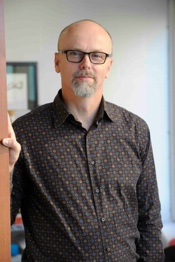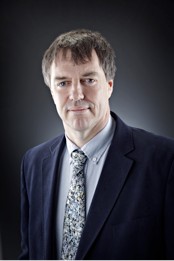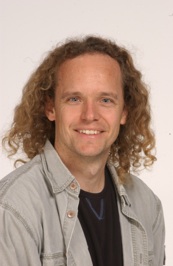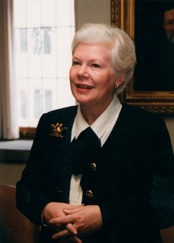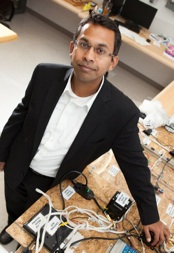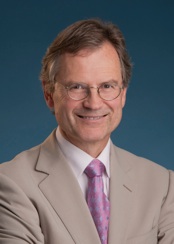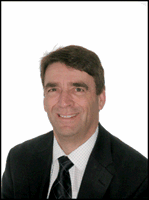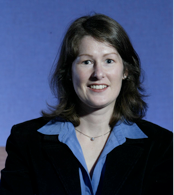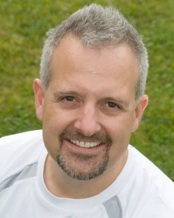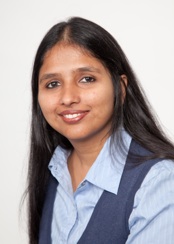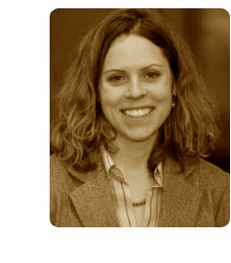Table 13: Douglas Bradley, Director of the Division of Respirology and Professor, Faculty of Medicine, University of Toronto
Sleep Apnea – Is it a Treatable Cause of Cardiovascular Diseases?
Sleep apnea is generally thought of as a disease of the obese in whom the main consequence is sleepiness. However, sleep apnea often occurs in the non-obese, in whom sedentary living leads to fluid accumulation in the legs during the day and displacement of this fluid into the neck when lying down at night causing sleep apnea by obstructing the throat. Sleep apnea appears to be a cause of several cardiovascular diseases, but frequently remains undiagnosed and untreated in such patients because many do not complain of being sleepy, and lack access to a sleep laboratory for diagnosis. If sleep apnea is a consequence of sedentary living, what can we do to combat this? Does treating non-sleepy patients with sleep apnea reduce their risk of developing cardiovascular diseases? Can we diagnose sleep apnea in the home without the need for access to a sleep laboratory?
Douglas is physician, scientist, and Director of the Sleep Research Laboratories of the Toronto Rehabilitation Institute and Toronto General Hospital. His clinical and research work focus on the causes and consequences of sleep apnea and of its treatment on cardiovascular diseases, especially heart failure, hypertension and stroke. His work is supported by many agencies and he has published extensively on sleep apnea and related topics. Douglas is regularly invited to speak on sleep apnea and its cardiovascular consequences around the world and he regularly speaks to the public and lay audiences about sleep-related matters.
Table 14: Jeremy Laurin, President and CEO, ventureLAB
How Crowd Sourcing Impacts Innovation Portfolio Management
Whether it is called social media, community engagement, crowd capital, predictive markets, wikis or just simply crowd sourcing, having access to this cognitive surplus has become key to any innovation strategy or program. In this discussion we explore how crowd sourcing impacts open innovation drawing on generation, market needs and opportunities all to fuel a balanced portfolio with actionable innovation challenges. It converges these with a need driven approach to source the ways of 'doing things right'. Open Innovation, a super-set of crowd sourcing, is an important component in the innovation ecosystem and can be highly effective in managing dispersed knowledge.
Jeremy is the President and CEO of ventureLAB, York Region's Premier Regional Innovation Centre and member organization of the Ontario Network of Excellence. Jeremy has responsibility for operations of the organization which includes: Municipal, Regional, Provincial and National mandates, innovation programs for companies ranging from entrepreneur development and support, to helping connections with York Regions largest tech sector giants. Jeremy has worked internationally opening offices throughout the European Union, China, Korea, Japan and the U.S.A.
Table 15: Bala Venkatesh, Associate Professor, Department of Electrical and Computer Engineering, Ryerson University; Academic Director, Centre of Urban Energy
Energy Economics - Coming of New Products (Storage), Sources (Renewables), Energy (Fracking)
This and the next decade will be transformative in the energy spectrum. Fundamental changes are being witnessed in the way we produce and deliver energy in the electricity sector. Renewables, fundamentally different from conventional generators, hydro-electric included, are now poised to form a significant portion of electric energy supply. Supply system/transmission of energy is changing as it adapts storage systems. Finally, the source of energy is now being transformed in North America; e.g. the Bakken oil boom and fracking. All of these are transformative and hold the potential to alter the national economic profile.
Bala is the Academic Director of the Centre of Urban Energy and is an Associate Professor in the Department of Electrical and Computer Engineering at Ryerson University. Before joining Ryerson University in 2008, Bala worked at Crompton Greaves, India, in the Large Power Transformer division. Later, he held positions as a Lecturer in Anna University, India, as an Associate Professor in Multimedia University in Malaysia, and as Associate Professor in the University of New Brunswick. In June 2010, Bala was appointed as founding Academic Director of the Centre for Urban Energy. Bala is a Senior Member of the IEEE and a registered Professional Engineer in Ontario.
Table 16: Michael Gardam, Director, Infection Prevention and Control, University Health Network
First Do No Harm: Healthcare Culture and Patient Safety
Medical adverse events are one of the leading causes of death in Canada: infections alone account for up to 12,000 deaths per year. Despite being aware for decades of the seriousness of these events, the healthcare system has been very slow to adopt successful improvement strategies. A lack of recognition of the complexity of healthcare, the power of culture (culture eats strategy for breakfast), and a tendency to rely on strategies that are more appropriate for simpler problems are major reasons why we have not moved forward.
Michael is an Associate Professor of Medicine at the University of Toronto and Director of Infection Prevention and Control at the University Health Network and former Director of Infectious Disease Prevention and Control at Public Health Ontario. He has devoted his career to discovering and uncovering new ways to prevent the spread of infectious diseases in healthcare settings and the community. He is an expert international consultant on several issues such as organizational behavioural change, infection prevention and control, and infectious diseases including Clostridium difficile, influenza, tuberculosis and hospital superbugs.
Table 17: Amy Caudy, Assistant Professor, Terrence Donnelly Centre for Cellular and Biomolecular Research and Department of Molecular Genetics, University of Toronto
Nutrition and Metabolomics
The next time you enjoy a meal, take a moment to marvel how your body can digest such a vast array of foods. With the availability of the complete genome sequences of organisms from yeast to man, we now know the full catalogue of genes for each. However, such lists only hint at how organisms process nutrients. Each cell in our bodies must take in nutrients to maintain itself. If so directed by environmental cues, our cells alter their metabolism in order to produce the building blocks necessary to divide. Now, new tools for chemical analysis permit much more sophisticated and intensive study of the metabolome, the chemical intermediates of cellular metabolism. These metabolomics tools are being applied to discover biochemical markers of disease, to develop more efficient methods for biofuel production, to identify organisms useful in bioremediation, and to understand the enzymes necessary for our cells to maintain themselves and grow.
Amy is an assistant professor in the Terrence Donnelly Centre for Cellular and Biomolecular Research and the Department of Molecular Genetics at the University of Toronto. Her laboratory is dedicated to the discovery of new biochemical pathways. One recent success is the discovery of a new biochemical pathway that generates ribose, the building block of RNA and DNA. Amy’s metabolic work is complemented by her work to develop and innovate genome-scale methods for working with yeast and other organisms. Amy is an author of the textbook, Recombinant DNA: Genes and Genomes.
Table 18: Shohini Ghose, Associate Professor, Physics and Computer Science; Director, Centre for Women in Science, Wilfrid Laurier University
Quantum Technologies: Hype or Hope?
The weird but wonderful laws of quantum physics can be exploited to design incredibly powerful quantum computers and novel communication protocols such as teleportation and unbreakable cryptography. How does quantum theory provide us with new approaches to information processing? What are the challenges we face in building next generation quantum devices? What are the potential benefits? Will quantum technologies transform your life and fuel our economy?
Shohini obtained her PhD in physics in 2003, and held an Alberta Ingenuity Postdoctoral Fellowship at the University of Calgary before joining Wilfrid Laurier University. She is an award-winning researcher in quantum information science and quantum chaos, and is affiliated with the Perimeter Institute for Theoretical Physics in Waterloo. She is a passionate educator, and recently co-authored Canada’s first introductory astronomy textbook. A driving force behind creating Laurier’s Centre for Women in Science, she serves as its first Director.
Table 19: Elizabeth Dowdeswell, O.C., President and CEO, Council of Canadian Academies; Former UN Under-Secretary General; Executive Director of UNEP; Founding President and CEO, NWMO
Insight and Impact – Linking Science, Knowledge and Policy
Canadians and their governments and institutions face a complex world of increasing interdependence, fast-paced change and emerging technologies. It is not surprising then that there is also increased demand for public policy to be informed by science and knowledge. This was, at least in part, the impetus for the creation of the Council of Canadian Academies.
Elizabeth’s eclectic public service career has spanned provincial, federal and international borders and transcended traditional disciplinary lines. Elizabeth served as Executive Director of the United Nations Environment Program and Under-Secretary General of the United Nations, Assistant Deputy Minister of Environment Canada responsible for the National Weather and Atmospheric Agency, and led a number of public inquiries, including into Canada’s unemployment benefits program and federal water policy. Elizabeth was appointed a Pierre Elliot Trudeau Foundation mentor, is a Corporate Director, and contributes in an advisory capacity to a number of not-for-profit organizations.
Table 20: Dan Hoornweg, Associate Professor and Jeff Boyce Research Chair, Faculty of Energy Systems, University of Ontario Institute of Technology
Sustainable Cities – Why We Need to Get Better at Building, Powering and Managing Urban Areas
In 2008 the world passed the 50% urban level – more than half of us now live in cities. Canada was one of the world’s first countries to urbanize; the rest of the world is catching up in a hurry. The number of people living in cities will double again in the next few decades. What took the world some 200 years before is now being repeated in just fourty years. Sustainable, well-designed, well-managed and sustainably powered cities are one of the most important tasks facing humanity today.
Dan has worked with more than 400 cities in more than fifty countries – working together with them to identify more sustainable approaches to basic service provisions. By looking at cities as systems, services like solid waste management, enhanced resilience, and better energy supply emerge through an integrated approach. Dan joined UOIT’s Energy Systems Faculty in October 2012. Prior to that he spent twenty years at the World Bank in Washington DC. He was the Bank’s lead focal point for cities and climate change and sustainable cities. Dan has worked with many government agencies and private sector partners, prepared many reports on cities, and presented at many conferences, trying to thrash out how best we might move toward more sustainable cities.
Table 21: Nigel Smith, Director, SNOLAB
Astro-particle Physics in Extreme Environments: From Pit to Pole
The field of astro-particle physics connects observations at the largest scales, the evolution of galaxies and the Universe, to the physics at the smallest scales, by studying sub-atomic particles from astronomical sources. The detector systems used to study these fundamental particles are often operated in challenging or remote environments, including the South Pole and in some of the world’s deepest mines. We will discuss the challenges and exhilarations of operating world-class research projects in these extreme environments, and discuss the science programme being developed at SNOLAB, Canada’s deep underground research facility.
Prior to joining SNOLAB as Director in 2009, Nigel built dark matter detectors for 15 years. As group leader at the Rutherford Appleton Laboratory in the U.K., he led construction and operation of a research facility in a salt mine in North Yorkshire, where these dark matter detectors were operated. He was the first Briton to successfully ‘winter-over’ at the South Pole itself whilst searching for Galactic sources of ultra-high energy gamma rays, which formed his PhD project from the University of Leeds. He holds a visiting chair at Imperial College London, and adjunct professorships at Queen’s University and Laurentian University.
Table 22: Wendy Taylor, Associate Professor and Canada Research Chair in Experimental Particle Physics, Department of Physics and Astronomy, York University
Hunting the Higgs Boson Particle, the Magnetic Monopole and Other Subatomic Curiosities
Particle physics seeks to understand the fundamental laws of Nature by studying the smallest building blocks of matter and the ways they interact. The four-decade-long search for the postulated Higgs boson particle culminated in the July 2012 discovery that captured the imagination of people all over the world. However, the magnetic monopole, a particle postulated over one hundred years ago, remains elusive.
After obtaining her PhD at the University of Toronto, Wendy spent five years working as a research scientist for Stony Brook University based at the Fermi National Accelerator Laboratory, outside Chicago, USA before joining York's Department of Physics and Astronomy. She now performs her research at the CERN laboratory in Geneva, Switzerland on the ATLAS experiment at the Large Hadron Collider.
Table 23: Sarah Dickson, Associate Professor, Department of Civil Engineering, McMaster University; Director, Water Without Borders Graduate Program
To Frac or Not to Frac?
Fracking is an extremely controversial issue. While our standard of living requires an abundant supply of affordable energy, at what cost are we obtaining this energy? Oil companies and environmental advocates tell us very different stories about that cost – where does the truth lie?
Sarah received her PhD from the University of Waterloo in 2001, and joined the Department of Civil Engineering at McMaster University in 2002. Her research focus is in the field of hydrogeology, and specifically contaminant transport in fractured rock environments. She was the recipient of an Early Researcher Award in 2009 for her work on “Understanding the risk of microbiological contamination of groundwater posed by the presence of fractures”. She has supervised more than twenty Master’s and Doctoral students, three of whom have won ‘Best Paper’ awards and one of whom won the Governor General’s Academic Gold Medal.
Table 24: Patrick McGowan, PhD, Assistant Professor, Department of Biological Sciences, University of Toronto, Scarborough Campus
How do Environments Talk to Genes?
How much of our behaviour and physiology can be explained by the DNA we inherit from our ancestors and how much by the environment we experience? We now know that the environment can alter the way genes work for a lifetime, sometimes across several generations. We will discuss the relatively new field of environmental epigenetics and the ways in which findings in this field are revolutionizing our understanding of health, disease, and ourselves.
Patrick conducts research in the Center for Environmental Epigenetics and Development at UTSC and is also an assistant professor of Cell and Systems Biology and Psychology at the University of Toronto. His research on the impact of early life adversity on epigenetic changes in the brain has been featured in the Economist, the New York Times and the Toronto Star among other publications. He is an associate editor of the journal Frontiers in Epigenomics.
Table 25: Chris Eliasmith, Professor and Canada Research Chair, Centre for Theoretical Neuroscience, University of Waterloo
Real and Artificial Brains
Can we build an artificial brain? One that functions “just like” a human or animal brain? We will discuss the current state-of-the-art in brain models, both biologically realistic (Spaun, Blue Brain) and unrealistic (IBM’s Watson). We will discuss how these models work, as well as how the actual brain works, and consider the current and future state of machine intelligence.
Chris is jointly appointed in the departments of Philosophy and Systems Design Engineering at the University of Waterloo. He holds a cross appointment to Computer Science, and supervises students in these departments, as well as Psychology and Biology. He is currently Director of the Centre for Theoretical Neuroscience, and holds a Canada Research Chair in the field. His forthcoming book is called “How to Build a Brain”. His team has developed the world’s largest functional brain model Spaun (Semantic Pointer Architecture Unified Network), which has received broad coverage in the popular press. He has recently founded the company Applied Brain Research, Inc. to explore practical applications of his work.
Gala 2013 - Tables and Topics
(Thursday April 25 at MaRS)
There are twenty-five tables. Here are Tables 13 to 25.
For Tables 1 to 12, go HERE




